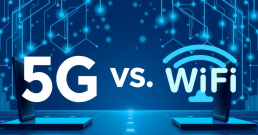The Future of Enterprise Applications: Transforming Business with Cloud and AI
Enterprise applications are the foundation of modern business operations. In 2023, the market expanded by 12%, reflecting its continued importance.
We can attribute this market growth to the following drivers:
- AI and Generative AI: The integration of AI and generative AI (GenAI) is transforming enterprise applications. From predictive analytics in CRM systems to personalized recommendations in ecommerce platforms, these technologies are making applications more intelligent and insightful.
- Cloud Dominance: Cloud technology is the present and the future of enterprise applications. Its ability to support technologies such as AI, machine learning, and the Internet of Things ensures that businesses can continue to evolve and adapt to internal and external needs and requirements.
- Ongoing Investments in Digital Transformation: Continuous digital transformation efforts are driving the adoption of enterprise applications, with organizations modernizing outdated systems and implementing innovative solutions across all business functions.
The Imperative of Enterprise Application Modernization
With more legacy systems reaching the end of their lifecycle — if only from a support perspective — and older platforms faltering under demand for increased agility, flexibility, and resilience, the modernization of enterprise applications has swiftly ascended organizations’ priority lists. In EMEA, application modernization has become a central focus, with an impressive 96% of surveyed organizations planning to undertake this essential transformation.
Challenges in Modernization
Each organization possesses a distinct approach to application modernization; no singular path forward exists. The complexities involved in modernizing applications across an enterprise demand a variety of tailored strategies — and this will likely remain the case.
Specific routes to modernization differ significantly by market, sector, and organization, with varied strategies emerging to address the diverse needs of different departments and their respective applications.
The Role of Cloud
While these strategies may differ, cloud technology stands out as the unifying force, having rapidly established itself as the preferred framework for both new and existing enterprise applications. Organizations are exploring multiple routes to modernization, with nearly half of those surveyed in EMEA expressing a desire to lift and shift their existing applications to the cloud.
Moreover, 43% aim to migrate to new cloud-based versions of their current applications, while 42% are eager to embrace entirely new cloud solutions.
Cloud: The Catalyst for Enterprise Transformation
Cloud technology is increasingly the foundation of organizations’ efforts to modernize their business applications. It empowers enterprises to swiftly adapt to shifting business needs, deploy updates seamlessly, and leverage cutting-edge technologies such as AI/GenAI, advanced analytics, and next-gen security.
Growth of Cloud-Based Applications
Cloud computing has massively fueled the growth of enterprise applications throughout EMEA. According to IDC’s May 2024 release of its software and public cloud services forecast, the enterprise apps market will continue to expand hugely — from $27.2 billion in 2019 to an estimated $63.7 billion in 2028 — reflecting a significant shift from on-premises to cloud-based applications.
The proportion of enterprise applications in public cloud surged from 36% in 2019 to an astonishing 68% in 2023, reflecting a marked acceleration in the growth of public cloud usage throughout the region. By migrating to cloud, companies can enhance performance, bolster security, and ensure superior disaster recovery. Cloud’s role as a crucial component of modern IT strategies has solidified.
Factors Driving Cloud Adoption
Additionally, the rise of remote work — especially during the pandemic — alongside regulatory compliance needs and the integration of emerging technologies, has further catalyzed cloud adoption. With the ongoing establishment of local cloud datacenters and numerous partnerships formed by enterprise application providers, we predict that cloud-based enterprise applications will continue to expand, reaching nearly 77% of all enterprise applications in 2028.
Regional Insights: EMEA Market Dynamics
From a subregional perspective, Western Europe commands a dominant position in the region, holding EMEA market share of 88%. This dominance can be attributed to the strong presence of companies like Visma and DATEV, which primarily focus on financial applications, payroll management, and HCM within Western European markets. Global giants such as SAP, Oracle, and Sage also maintain significant footholds in this subregion.
In contrast, each of the Central & Eastern Europe (CEE) and the Middle East & Africa (MEA) subregions accounts for EMEA enterprise applications market share of 6%.
However, CEE has recorded a decline in spending due to several challenging macroeconomic factors.
The protracted Russia-Ukraine War, which began in February 2022, has introduced notable economic instability in the subregion. High inflation rates have diminished the spending power of businesses, while stringent monetary policies have adversely impacted software investments, resulting in a significant decline in 2022 and sluggish recovery in 2023.
On the flip side, MEA has experienced substantial growth over the past four or five years, largely driven by the emergence of cloud and cloud-based services in 2018 and 2019. This growth has been bolstered by considerable investments from cloud providers.
Organizations and large family-owned enterprises in MEA, previously reliant on monolithic legacy applications, have begun adopting SaaS solutions for non-critical workloads such as HCM, procurement, and asset management. They have thus far been successful in their overall application modernization efforts, with a growing number of businesses re-architecting, re-platforming, and re-engineering their in-house legacy systems.
Navigating the Complexity of Cloud Migration
As organizations consider their enterprise application investments and modernization opportunities and the advantages of cloud migration, they are exploring the most effective implementation paths for their new cloud-based applications. In the past, heavily customized implementations were the preferred route, as organizations sought to tailor their applications to better suit their operations.
However, a noticeable shift is occurring as organizations increasingly embrace a more standardized implementation approach.
Approximately 31% of respondents plan to rely solely on standard functions and configurations for their new cloud-based applications, while 42% are contemplating only essential modifications — typically, those focused on sector-specific functionality — to maintain otherwise predominantly standardized implementations.
The Benefits of Standardization
The preference for standardized approaches is motivated by clear and tangible benefits. For instance, as new security patches are released, organizations with more standardized implementations can rapidly update their systems without necessitating further testing. This capability ensures the most robust protections are in place as quickly as possible, without requiring additional investments in IT, security, or implementation capabilities.
Accessing New Features Quickly
Access to new features is another crucial factor. As the pace of change accelerates, organizations are eager to leverage new functionalities — such as GenAI and sustainability tools — immediately upon their release.
Typically, these enhancements are first introduced in cloud-based SaaS versions, with vendors maintaining slower update cadences for on-premises editions. Consequently, a more standardized implementation offers the quickest and most straightforward access to these emerging features and functionalities.
This inclination for less customized implementations ensures that organizations stay current with vendor innovations — ultimately, helping them maximize the benefits of their enterprise application modernization investments.
Conclusion
Enterprise application modernization is essential for businesses competing in the digital age. Cloud technology is key to this process, enabling agility and innovation. While modernization approaches vary, a trend is clear toward standardized solutions that maximize the benefits of cloud and AI, including GenAI.
To be successful, increase efficiency and competitiveness, and future-proof operations, organizations must take a comprehensive approach to modernization, considering not only specific business needs and appropriate technologies, but also data governance and sustainability.
This blog serves as a summary of the valuable insights shared during our recent webinar on enterprise application modernization. If you found this discussion on the transformative power of cloud technology and AI interesting, we invite you to access the full webinar on demand.
What Does the Future Hold for the Industrial Metaverse in Engineering?
In three years, I anticipate that around 40% of global engineering-oriented manufacturing companies will leverage digital twins within the industrial metaverse to enhance collaboration and accelerate time to value.
What leads me to this prediction? Let’s start with IDC’s definition of the industrial metaverse as a highly immersive environment that seamlessly integrates the physical and digital worlds, fostering shared presence, interaction, and continuity across engineering, operations, supply chains, and business functions.
In engineering domain, the industrial metaverse functions as a cloud-native, multi-domain platform for 3D visualization and collaboration, bringing products to life through integrated, physically accurate simulations. It acts as a “digital twin of digital twins,” utilizing real-time data from multiple domains such as mechanical, electrical, and software interactions.
Building this environment requires collaboration among key players, including hyperscalers and providers of simulation platforms, 3D visualization, and digital business tools. New partnerships are constantly emerging, involving major companies in digital infrastructure, cloud computing, engineering platforms, visualization technologies, and artificial intelligence — all working together to push the industrial metaverse beyond the traditional digital twin model.
What Do the Numbers Tell?
Product innovation remains a key business priority for engineering-focused manufacturing organizations, as highlighted in IDC’s 2024 Global Manufacturing Industry Core Survey (Figure 1).
Figure 1: Question: What are your company’s top business priorities over the next 2 years?
According to IDC’s 2023 Global Product and Service Innovation Survey, 25% of manufacturing respondents considered industrial metaverse technology to be “very important” for product and service innovation. This number was even higher among engineering respondents, with 34% rating it as very important.
Furthermore, 38% of respondents from companies with over 1,000 employees in IDC’s 2024 Global Manufacturing Industry Core Survey stated that Industrial Metaverse technology plays a “moderate to very high” role in supporting their company’s achievement of key operational KPIs.
As a result, the adoption of the industrial metaverse in engineering-focused manufacturing organizations is anticipated to grow steadily over the next three years.
In Conclusion
My advice for early adopters is to keep a close eye on hyperscalers, leading technology vendors, and the startup ecosystem — to stay up-to-date with the rapidly evolving landscape of industrial metaverse development. Additionally, remember that integrating real-world data with IT data to create advanced simulation and collaboration tools requires time and careful planning.
Building and nurturing digital communities and ecosystems is essential, as they will be key to future success in the industrial metaverse. Lastly, recognize that the value of the industrial metaverse extends beyond product design and engineering, reaching areas like operations, maintenance, quality, procurement, and the supply chain, among others.
Final Countdown to DORA: Prioritize, Plan, and Comply
As the January 2025 deadline for the EU Digital Operational Resilience Act (DORA) approaches, financial institutions and ICT providers across the European Economic Area (EEA) must urgently assess their readiness, address regulatory gaps, and implement the necessary tools and processes to ensure compliance and safeguard digital resilience.
On January 17, 2025, the EU Digital Operational Resilience Act will take effect across all European Economic Area countries. It will impact financial institutions and their ICT service providers even beyond these borders in certain circumstances.
With only three months remaining, more than 20,000 financial entities must comply with DORA’s regulatory requirements. However, in IDC’s European Security Technologies and Strategies Survey 2024 (May 2024), 49% of respondents stated, “We are aware of DORA but have not yet undertaken exploratory work,” and 14% admitted, “We are not aware of DORA.”
Since then, progress has hopefully been made, driven by active market debates and numerous educational initiatives aimed at increasing awareness. Still, with just a few weeks before the deadline, financial entities and ICT providers must assess their current standing and identify the efforts required to bridge the gaps. Now is the time to prioritize, plan, and comply:
- PRIORITIZE the gaps that need addressing
- PLAN for tools and process improvements (extending beyond January 2025)
- COMPLY with the deadline
Let’s take a step back to recap the scope and objectives of this EU regulation.
Scope: Harmonization and Augmentation
DORA introduces two key innovations:
- Harmonization: DORA harmonizes regulatory requirements across different financial industries, covering banking, insurance, capital markets players, and adjacent players such as credit rating agencies. This harmonization eliminates fragmentation across jurisdictions by implementing a regulation (not a directive), ensuring common requirements across all member countries.
- Augmentation: DORA marks a paradigm shift, bringing ICT third-party providers under the direct scrutiny of the European Financial Supervisory Authorities. As previously discussed in our blog, EU regulators have acknowledged the growing dependency of financial organizations on ICT and cloud service providers. Given that digitalization and operational resilience are two sides of the same coin, implementing a robust digital operational resilience framework significantly enhances security for banking operations. By placing critical third-party ICT service providers under direct supervision, regulators have reshaped the dynamics between financial entities and their ICT partners.
For financial entities, DORA provides the framework for tighter collaboration with ICT partners to ensure end-to-end operational robustness. For ICT partners, DORA is not just a new regulatory burden, but an opportunity to deepen relationships with clients and explore new business avenues, as financial entities are required to conduct market research and define alternate solutions for each critical function.
Objectives: Mitigating Systemic Risk
The primary objective of DORA is to address the systemic risk posed by critical ICT service providers in the financial industry. By involving European supervisory authorities (e.g., EBA, ESMA, EIOPA) directly, regulators aim to mitigate this risk and enhance the overall digital resilience of the financial sector.
DORA’s requirements fall under five pillars:
- Risk management
- ICT third-party risk management
- Digital operational resilience testing
- Mandatory incident reporting
- Voluntary information and intelligence sharing
Additionally, financial entities must define clear exit strategies to mitigate systemic risk in the event of operational issues with an existing ICT partner. Each entity must identify and choose alternative solutions and service providers to ensure the smooth transfer of critical services, if necessary.
For ICT vendors, DORA is a double-edged sword: While it opens up new opportunities and makes the market more fluid, it also imposes additional compliance obligations.
It is important to note that many DORA requirements are not new to large institutions, particularly significant banks subject to the ECB’s Single Supervisory Mechanism. The principle of proportionality still applies under DORA. Nonetheless, its impact is extensive, as evidenced by the IDC survey, wherein 38% of respondents cited digital operational resilience testing as their biggest challenge, while 33% identified ICT third-party risk management as a major hurdle.
Final Steps: Self-Assessment and Planning
With the deadline approaching, each institution must conduct a self-assessment to identify gaps. Where significant gaps remain, organizations must prioritize efforts to meet compliance requirements. Meanwhile, financial entities should plan for the adoption of new tools and processes, such as integrated procurement solutions, to enhance third-party governance and address DORA holistically as part of their ongoing journey toward digital operational resilience.
Are you ready for DORA? Discover the 10 critical steps financial entities must take before the regulation comes into effect in January 2025: IDC PlanScape: Last-Call DORA Compliance Checklist to Achieve Digital Operational Resilience
5G vs WiFi: Which Technology Will Power the Networks of Tomorrow?
On October 3, I had the privilege of participating in a thought-provoking panel at DTX London 2024. The discussion revolved around one of the most pressing questions in the telecommunications industry: 5G versus Wi-Fi: Which technology will drive the future of connectivity?
As a 5G/mobility analyst at IDC in Europe, I was invited to join Paul Ridge, Director Consultant at 4C Strategies, and Dan Jones, Technologist at Hamina Wireless, to explore the opportunities, challenges, and future landscape of these two critical technologies.
The European Telecom Market: Facing Stagnation and Seeking New Growth
Before diving into the core debate, it’s essential to acknowledge the broader telecom market dynamics. The European telecom sector faces an array of challenges, including stagnating revenues, intensified competition from both traditional telcos and OTT players, and strict regulatory pressures.
Working closely with our telco colleagues around the world, IDC covers these issues across a range of research programs. As shown in IDC’s European 5G program (European 5G and Internet of Things Monetization and Adoption Strategies), price wars have squeezed margins, leaving telcos struggling to raise prices while shouldering the costs of 5G and fiber rollouts.
Telecom operators are pivoting toward service diversification, investing heavily in digital services, and shifting their strategies to seek new revenue streams beyond connectivity. This is where the conversation around 5G and Wi-Fi becomes especially significant.
5G: A Game-Changer for Telecoms
5G, particularly standalone (SA) networks, offers a lifeline for operators seeking to overcome revenue stagnation and expand into new business models. During the panel, I emphasized five key aspects of 5G SA that make it a cornerstone of future connectivity.
- Clean-Slate Architecture: 5G SA doesn’t rely on legacy technologies. This enables optimized network design, enhanced innovation, and greater flexibility.
- Cloud-Native Core: With a cloud-native foundation, operators can scale services dynamically, implement tailored network slices, and respond in real time to evolving user needs.
- Mobile Private Networks (MPNs): These enable businesses to deploy their own secure, private 5G networks that offer enhanced security, control, and reliability. MPNs also enable enterprises to run mission-critical applications independently from public networks.
- Network Slicing: This enables the creation of virtual, customized networks that cater to specific application requirements, such as ultra-reliable connectivity for autonomous vehicles or low-latency service for Smart Cities.
- Support for Key Traffic Types: The flexibility of 5G SA accommodates enhanced mobile broadband (eMBB), massive machine-type communications (mMTC), and ultra-reliable low-latency communication (URLLC), optimizing the network for a wide variety of use cases.
5G’s potential is immense — but its deployment in Europe has been slower than anticipated. To date, just 18 operators have launched 5G SA networks in Western Europe, and only a handful have commercialized network slicing capabilities.
Wi-Fi: The Complementary Force
5G offers compelling advantages, but Wi-Fi continues to be a dominant force, especially in residential and enterprise environments. The ubiquity of Wi-Fi, its ease of deployment, and lower cost make it an attractive option for fixed-location connectivity. However, Wi-Fi has limitations in mobility, security, and reliability — which is where 5G shines.
During the panel, we discussed how Wi-Fi remains ideal for specific customer requirements, such as indoor environments or smaller businesses with less demanding connectivity requirements. However, when mobility, low latency, and security are paramount, 5G emerges as the superior choice.
When 5G Outshines Wi-Fi
The results of IDC’s European 5G/IoT Survey 2024 highlighted that organizations are increasingly demanding mobile connectivity that extends beyond fixed locations. Nearly 70% of respondents said yes when asked, “Does your organization need mobile connectivity that extends beyond a fixed campus or location for anything other than personal devices?”
Businesses are looking for mobile solutions that enable them to monitor supply chains, manage remote operations, and ensure connectivity in dynamic environments.
Security remains a top concern, with 33% of survey respondents identifying enhanced security for data transmission and communication as their primary challenge. This has led to an increasing preference for keeping data in-house: Almost 49% of businesses cited trust and security concerns as a key reason for this choice.
This is where 5G MPNs come into play, offering businesses the security and control they need to manage sensitive data while generating new revenue streams through advanced digital services. According to IDC’s forecasts, the European MPN managed services market is expected to expand to a value of $818 million in 2028, with the MPN professional services market (including integration and consulting) projected to reach $615 million the same year.
In industries where deploying MPNs may not be feasible — such as public transportation or emergency services — 5G SA network slicing offers a flexible, secure alternative. With 5G network slicing, operators can create customized virtual networks, guaranteeing service-level agreements (SLAs) and ensuring reliable service for applications like connected ambulances or public transport vehicles. More than one-third (36%) of respondents in IDC’s European Telco Survey 2024 identified network slicing as a key driver of implementing 5G SA.
The reasons why businesses might choose 5G over Wi-Fi in certain campus or short-range scenarios include:
- Security and End-to-End Control: 5G operates on licensed spectrum, offering higher levels of security compared to Wi-Fi, which uses unlicensed spectrum and is more vulnerable to interference and attacks. 5G networks enable operators to control and secure every part of the network from end to end, making it ideal for industries in which data protection is crucial.
- Mobility: When mobility is important — such as in scenarios involving moving machines or vehicles — 5G excels due to its ability to maintain seamless connections during handovers between cells. Wi-Fi struggles with handover scenarios, leading to potential service drops when devices move across different access points. This makes 5G the better option for uninterrupted service in mobile environments.
- Reliability in Aggressive Radio Environments: In radio-aggressive environments like factories, with machines and boxes creating interference, 5G’s micro-diversity and advanced signal handling capabilities make it more reliable than Wi-Fi. 5G’s ability to handle dark zones (areas with poor signal coverage) through reconfiguration also ensures consistent performance. Wi-Fi, however, may struggle in these areas.
- Ability to Offer SLAs: 5G allows network operators to guarantee SLAs, providing commitments on performance, uptime, and latency. Wi-Fi cannot consistently offer these assurances. This is especially important in industrial applications requiring high reliability and low latency. 5G can provide predictable and measurable outcomes.
- Control Over Different Parts of the Network: In 5G networks, operators have full control over network slices, traffic, and reconfigurations. This is essential in environments like manufacturing, where specific areas may need different levels of service or control. Customization at this level is difficult to achieve with Wi-Fi.
Blending 5G and Wi-Fi: The Future of Connectivity
Ultimately, the future of networking lies in the integration of 5G and Wi-Fi technologies. Each serves a distinct role in addressing the varying demands of consumers and businesses. Smartphones, for example, effortlessly switch between Wi-Fi and 5G depending on network quality, and this hybrid approach will likely become the norm across multiple industries.
Looking ahead, the combination of 5G’s robustness and Wi-Fi’s accessibility will enable a more flexible, efficient, and connected future. Telecom operators will continue leveraging both technologies to build the next generation of networks that deliver high-speed, secure, and reliable connectivity for all.
For more info on addressing growth in the telco space, please register for the following webcast: Addressing the telco growth imperative in EMEA















